 W
WThe Arfak Astrapia is a species of Astrapia, a group of birds found in the Paradiseidae family of the birds-of-paradise.
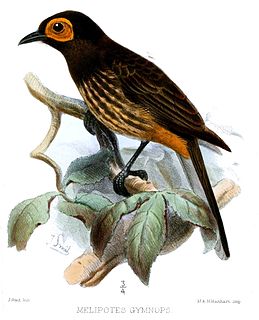 W
WThe Arfak honeyeater or bare-eyed honeyeater is a species of bird in the family Meliphagidae. It is endemic to West Papua, Indonesia, where it lives in subtropical and tropical moist montane forest, at elevations ranging from 1,200 to 2,700 m.
 W
WThe piping bellbird, or crested pitohui, is a species of bird in the family Oreoicidae. It was previously placed in the family Pachycephalidae.
 W
WThe Biak black flycatcher or Biak flycatcher is a species of bird in the family Monarchidae. It is endemic to Biak, Indonesia.
 W
WThe Biak scops owl is an owl endemic to the twin islands of Biak-Supiori in Geelvink Bay, Papua, Indonesia. It is classified as Vulnerable due to its very small range and destruction of its habitat. Biak Scops Owls are 20–25 cm birds from the Genus Outs contain 45 other species. Biak Scops are frequently seen as dark brown and dark rufous forms with long ear tufts and pale a whitish brown facial disc. Baik's are very small creatures, but have hoarse, corvid- like voices. Their diet mostly consist of small vertebrates or insects, although due to being an ongoing decline they are seldom seen; however, most are found in Blaik Island in heavy wooded areas near villages in Supiori Islands off northwest New Guinea. However, the reproducing of Biak Scops Owls is unknown and is still in the process of studying.
 W
WThe Biak white-eye is a species of bird in the family Zosteropidae. It is endemic to West Papua, Indonesia.
 W
WWilson's bird-of-paradise is a species of passerine bird of the family Paradisaeidae.
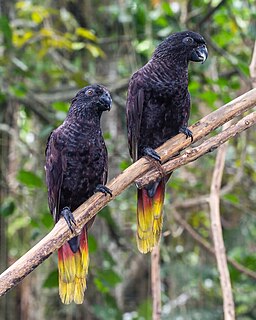 W
WThe black lory also known as rajah lory or red-quilled lory is a medium-sized, blackish parrot with black bill, dark grey feet and long rounded tail. It has yellow and red under-tail. The sexes are similar. It is native to West Papua in Indonesia.
 W
WArchbold's bowerbird is a medium-sized, dark grey songbird with brown iris, grey feet and black bill. They can grow up to 37 cm long. The male has narrow black scalloping with some trace of golden yellow crown feathers and dark grey forked tail, that shorter than the wing. Both sexes are similar. The female is smaller than male, with yellow patch on wings and has no crown feathering.
 W
WThe golden-fronted bowerbird is a medium-sized, approximately 24 cm long, brown bowerbird. The male is rufous brown with an elongated golden crest extending from its golden forehead, dark grey feet and buffish yellow underparts. The female is an unadorned olive brown bird.
 W
WThe Vogelkop bowerbird, also known as the Vogelkop gardener bowerbird, is a medium-sized, bowerbird of the mountains of the Vogelkop Peninsula at Western New Guinea, Indonesia.
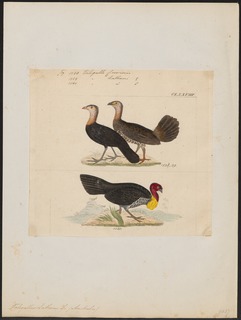 W
WThe red-billed brushturkey also known as red-billed talegalla or Cuvier's brushturkey, is a large, up to 57 cm long, black megapode with bare yellow facial skin, a reddish orange bill, yellow iris, and orange feet. The head is covered with bristle-like black feathers. The sexes are similar.
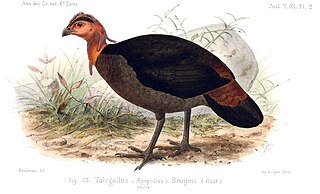 W
WThe Waigeo brushturkey or Bruijn's brushturkey is a large brownish-black megapode with a bare red facial skin, red comb, maroon rump and chestnut brown below. There are two elongated red wattles on the back of the head and a long wattle on the foreneck. Both sexes are similar. The female has a smaller comb and no wattles.
 W
WThe Arfak catbird is a species of bowerbird (Ptilonorhynchidae) which can be found in the Bird's Head (Vogelkop) Peninsula in western New Guinea.
 W
WThe crinkle-collared manucode is a species of bird-of-paradise.
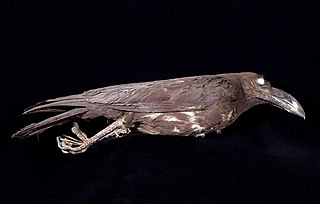 W
WThe brown-headed crow is a passerine bird of the genus Corvus in the family Corvidae. Endemic to Indonesia, it has a fragmented distribution in subtropical or tropical moist lowland forest and subtropical or tropical mangrove forest. It is threatened by habitat destruction and the IUCN has rated it as being "near-threatened".
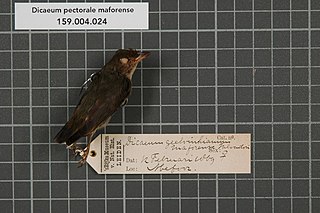 W
WThe olive-crowned flowerpecker is a small passerine bird in the flowerpecker family, Dicaeidae. It is found in far western New Guinea and on adjacent islands. There are two subspecies: D. p. ignotum on Gebe Island and D. p. pectorale elsewhere. The red-capped flowerpecker and Louisiade flowerpecker are sometimes included in this species.
 W
WThe little grassbird is a species of Old World warbler in the family Locustellidae. It is found in Australia and in West Papua, Indonesia. These sexually monomorphic birds are found in reed beds, reeds lignum swaps and salt marshes of South Eastern Australia.
 W
WThe orange-cheeked honeyeater is a species of bird in the family Meliphagidae. It is monotypic within the genus Oreornis. It is endemic to West Papua, Indonesia. Its natural habitat is subtropical or tropical moist montane forests.
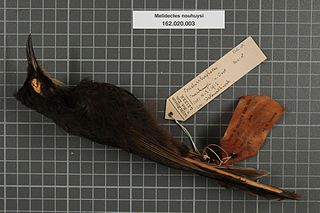 W
WThe short-bearded honeyeater is a species of bird in the honeyeater family Meliphagidae. It is found mainly in West Papua. Its natural habitat is subtropical or tropical moist montane forests.
 W
WThe Australian white ibis is a wading bird of the ibis family, Threskiornithidae. It is widespread across much of Australia. It has a predominantly white plumage with a bare, black head, long downcurved bill and black legs. While its sister species is the African sacred ibis, the Australian white ibis is a native Australian bird - contrary to urban myth it is not a feral species introduced to Australia by people, and it does not come from Egypt.
 W
WThe Biak paradise kingfisher is a tree kingfisher that is endemic to the Indonesian island of Biak which is one of a small group of islands located in Cenderawasih Bay near the northern coast of Papua. This bird has a turquoise-blue back with a white belly and tail streamers and a reddish beak. Its natural habitat is forests and the IUCN has assessed its conservation status as being "near-threatened".
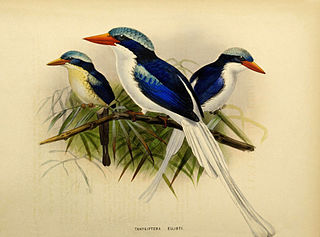 W
WThe Kofiau paradise kingfisher is a tree kingfisher endemic to the Indonesian island Kofiau. This little-known bird is sometimes considered a subspecies of the common paradise kingfisher, but it is morphologically distinct and del Hoyo lists it as a separate species.
 W
WThe Numfor paradise kingfisher, also known as the cobalt paradise kingfisher, is a tree kingfisher endemic to the Indonesian island of Numfor off the northwestern coast of New Guinea. It is a common species, but the forests where it lives are being affected by logging and the IUCN has rated its conservation status as "near-threatened".
 W
WThe Biak lorikeet, also known as Rosenberg's lorikeet, is a parrot in the family Psittaculidae. Formerly lumped in with Trichoglossus haematodus, it is endemic to the twin islands of Biak and Superiori in the Papua province of Indonesia.
 W
WThe black-winged lory also known as Biak red lory is a medium-sized, about 30 cm (12 in) long, long-tailed lory. It has a bright red plumage, black shoulder, red iris, an orange red bill and violet ear-patch behind eye. The underwings are red, becoming yellowish with black tips. Both sexes are similar.
 W
WThe black-breasted mannikin or black-breasted munia is a species of estrildid finch endemic to West Papua, Indonesia. It has an estimated global extent of occurrence of 20,000 to 50,000 km². It is found in subtropical/ tropical lowland dry shrubland and high altitude grassland habitat. The status of the species is Least Concern.
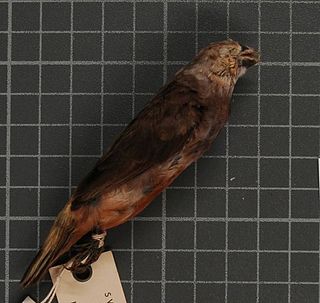 W
WThe grey-banded mannikin or grey-banded munia, is a species of estrildid finch is known to be found in Anggi Gigi, Tamrau Mountains and Arfak Mountains in the Vogelkop Peninsula in north-west Papua, Indonesia. This species inhabits at mid-mountain wet grassland and marshland. It also can be found at abandoned agricultural plots, near human settlements.
 W
WThe black pitohui is a species of bird in the monotypic genus of Melanorectes in the family Pachycephalidae. It is found throughout the highlands of New Guinea. Its natural habitat is subtropical or tropical moist lowland forests.
 W
WThe Vogelkop melidectes is a species of bird in the family Meliphagidae. It is endemic to West Papua, Indonesia.
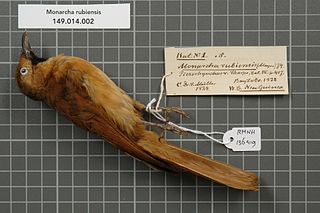 W
WThe rufous monarch, or rufous monarch flycatcher, is a species of bird in the family Monarchidae found in western New Guinea. Its natural habitat is subtropical or tropical moist lowland forests.
 W
WThe piping bellbird, or crested pitohui, is a species of bird in the family Oreoicidae. It was previously placed in the family Pachycephalidae.
 W
WArchbold's owlet-nightjar is a species of bird in the family Aegothelidae. It is found mainly in West Papua. Its natural habitat is subtropical or tropical moist montane forests. It is named after American explorer Richard Archbold.
 W
WThe Vogelkop owlet-nightjar or allied owlet-nightjar, is a species of bird in the family Aegothelidae. It can be found in New Guinea. It is known from Bird's Head Peninsula and Eastern Highlands Province.
 W
WThe long-tailed paradigalla is a large, approximately 37 cm long, black bird-of-paradise with long and pointed tail. One of the most plain members in the family Paradisaeidae, its only adornment is the colorful facial wattles of yellow, red and sky-blue near base of the bill. Both sexes are similar in appearance, however the female is slightly duller and smaller.
 W
WThe bronze parotia, also known as the Foja parotia, Berlepsch's parotia or Berlepsch's six-wired bird-of-paradise, is a species of bird-of-paradise, in the family Paradisaeidae. It resembles and is often considered to be a subspecies of Carola's parotia, but a high majority of authorities support its specific status.
 W
WThe large fig parrot, also known as flame-headed fig parrot and Desmarest's fig parrot, is a species of parrot in the family Psittaculidae. It is found in the West Papuan Islands, Indonesia and in southern and western New Guinea.
 W
WSalvadori's fig parrot is a species of parrot in the family Psittaculidae endemic to the northern part of the Papua province in Indonesia.
 W
WThe Moluccan king parrot is a parrot endemic to Peleng Island, Maluku, and West Papua in Indonesia. It is sometimes referred to as the Ambon king parrot or Amboina king parrot, but this is potentially misleading, as it is found on numerous other islands than Ambon. The male and female are similar in appearance, with a predominantly red head and underparts, green wings, and blue back and tail. Six subspecies are recognised, but only a few of these are regular in aviculture. In the wild, it inhabits rainforests and feeds on fruits, berries, seeds and buds.
 W
WThe Geelvink pygmy parrot is a species of parrot in the family Psittacidae endemic to Biak and Numfoor islands in Western New Guinea. The name Geelvink comes from a Dutch ship and family called Geelvinck. It has two subspecies; the nominate occurs on Numfor, and M. g. misoriensis on Biak.
 W
WThe yellow-capped pygmy parrot is a species of parrot in the family Psittacidae found in Indonesia and Papua New Guinea. Its natural habitats are subtropical or tropical moist lowland forest, subtropical or tropical mangrove forests, and subtropical or tropical moist montane forest. Like many parrots, this pygmy parrot is affectionate to its mate. It is currently unknown if they remain monogamous for life like many bigger parrots because of their isolated location, which is difficult to reach.
 W
WThe western crowned pigeon, also known as the common crowned pigeon or blue crowned pigeon, is a large, blue-grey pigeon with blue lacy crests over the head and dark blue mask feathers around its eyes. Both sexes are almost similar but males are often larger than females. It is on average 70 cm (28 in) long and weighs 2,1 kg(4.6 lbs).
 W
WThe barred rail is a species of bird in the rail family Rallidae. The species was formerly placed in the genus Rallus.
 W
WThe chestnut forest rail, also known as the chestnut forest crake, is a species of bird in the family Sarothruridae. It is found in the Arfak Mountains and western-central New Guinea Highlands. Its natural habitat is subtropical or tropical moist montane forests.
 W
WThe red bird-of-paradise, is a bird-of-paradise in the genus Paradisaea, family Paradisaeidae.
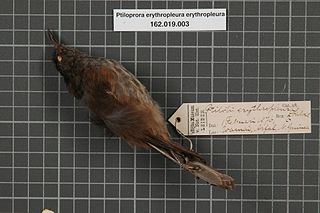 W
WThe rufous-sided honeyeater is a species of bird in the family Meliphagidae. It is endemic to West Papua, Indonesia.
 W
WThe Biak scrubfowl or Biak megapode is a species of bird in the family Megapodiidae. It is found only on the islands of Biak, Mios Korwar, Numfor, Manim and Mios Numin in the West Papua region of Indonesia.
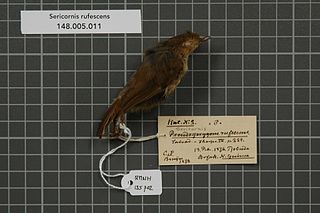 W
WThe Vogelkop scrubwren is a bird species in the family Acanthizidae. It is endemic to West Papua, Indonesia. Its natural habitat is subtropical or tropical moist montane forests.
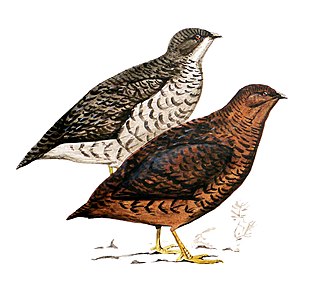 W
WThe Snow Mountain quail, is a large, approximately 28 cm (11 in) long, dark brown quail of Alpine grasslands. It is the only member of the genus Anurophasis. It has a brown plumage, a horn-coloured bill, yellow legs and a brown iris. The underparts of the female are whitish and more heavily black barred than in the male.
 W
WThe long-tailed starling is a species of starling in the family Sturnidae. It is endemic to the Schouten Islands off West Papua, in Indonesia, an important area of bird endemism. The species was once treated as part of a superspecies with the shining starling. There are two subspecies, the nominate race, which occurs on Biak, and brevicauda, which is found on Numfor Island. It occurs in a wide range of habitats at all altitudes, including natural forest and forest edges, as well as human modified secondary forests and gardens. In spite of its tiny global range the species is not considered threatened by human activities and remains common within its range, and is therefore listed as least concern by the IUCN.
 W
WThe wattled smoky honeyeater or Foja honeyeater is a species of honeyeater with a sooty-grey plumage and a black bill. The most distinctive feature is arguably the extensive reddish-orange facial skin and pendulous wattle. In other members of the genus Melipotes, these sections only appear reddish when "flushed" and the wattle is smaller.
 W
WThe western or Arfak parotia, is a medium-sized, approximately 33 cm long, bird-of-paradise with a medium-length tail.
 W
WThe Papuan whipbird is a species of bird in the family Psophodidae. It is monotypic within the genus Androphobus. It is found in Western New Guinea.